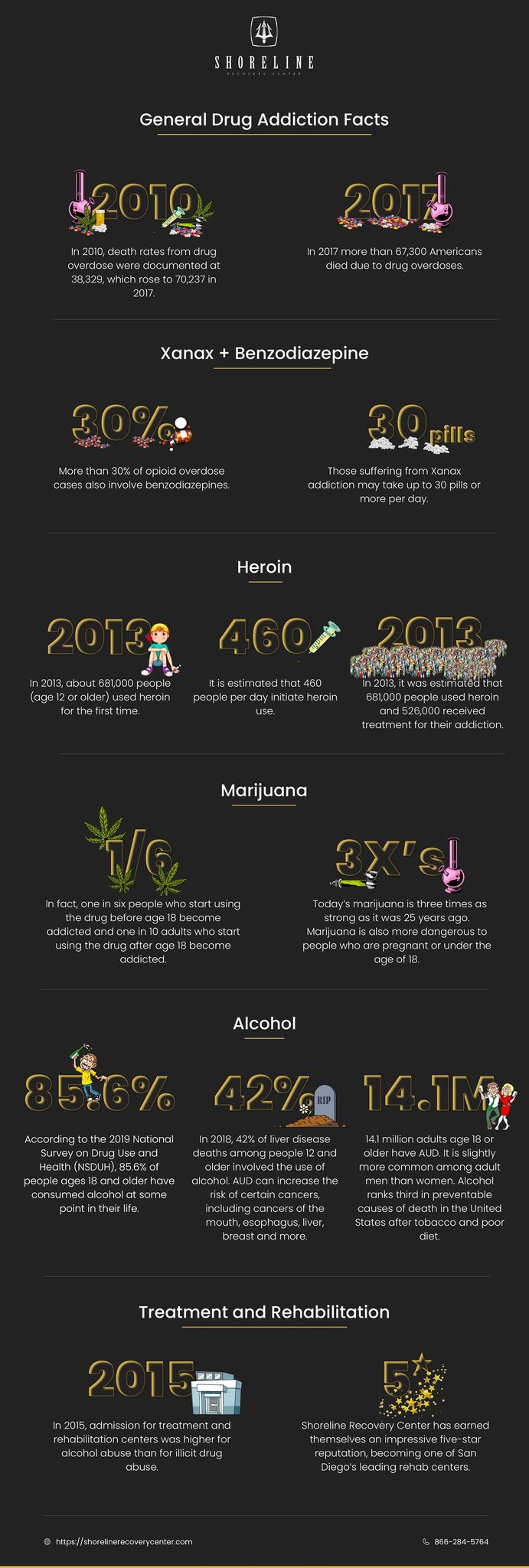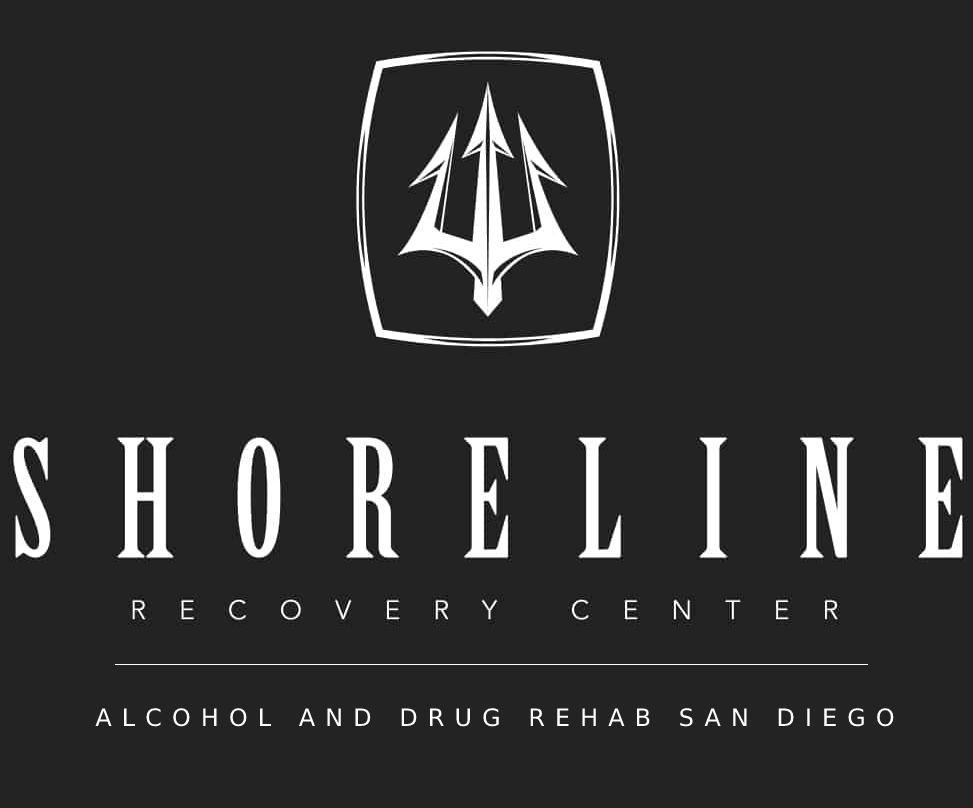Substance use disorder (SUD) is a serious chronic condition that many people across America face. Drug addiction causes a chemical reaction in a person’s brain that makes them seek out drugs. Anyone struggling with a drug addiction deserves to get the help that he or she needs.
General Drug Addiction Facts
Drugabuse.gov defines drug addiction as “a chronic disease characterized by drug seeking and use that is compulsive, or difficult to control, despite harmful consequences.” People who are addicted to drugs often go to any length to obtain them, even if it endangers themselves or others. Overuse of any drug can lead to chemical changes in a person’s brain that affect his or her self-control. Drugs flood people’s brains with dopamine, creating euphoria, and affecting the person’s reward circuit.
Normally, a person’s reward system is motivated by what a person needs to live a comfortable life. However, a drug-addicted person’s reward circuit is typically only motivated by drugs because of the excess of dopamine.According to drugabuse.gov, in 2017 more than 67,300 Americans died due to drug overdoses. In 2010, death rates from drug overdose were documented at 38,329, which rose to 70,237 in 2017. In order to prevent deaths by overdose, it is important to document the use of specific drugs to provide the right amount of treatment for those who need it.
Xanax and Benzodiazepine Addiction Facts
Xanax is a benzodiazepine, which is a class of drugs usually prescribed to treat generalized anxiety disorders, panic disorders, social disorders, insomnia, and seizures. Benzodiazepine addiction can be worse when combining with other drugs such as opioids or narcotics. More than 30% of opioid overdose cases also involve benzodiazepine. Both opioids and benzodiazepines are commonly prescribed to people with anxiety disorders and are sometimes prescribed simultaneously to a patient.
However, both opioids and benzodiazepine are known to sedate users and suppress their breathing, making the combination very dangerous. Furthermore, mixing these drugs often increases the risk of death associated with overdosing. While benzodiazepine is a legal drug, it can be fatal when misused. Any non-medical use of Benzodiazepine drugs such as Xanax is considered “misused” when it is not the user’s prescription, it is taken for reasons other than for what it is prescribed, or when the user is not following instructions for how the medication should be taken.
Heroin and Opioids Addiction Facts
Heroin is a highly addictive drug, partially because of how fast it affects a person’s brain.Heroin is an opioid drug because it is made from the seed pod of an opioid poppy plant. However, most opioid overdoses are due to pain medication, rather than heroin. According to the CDC, in 2018, 10.3 million people — ages 12 and older — misused opioids. Of that number, 9.9 million people misused prescription pain killers, while only 808,000 people were found to be using heroin. However, heroin use is on the rise. One theory suggests that heroin use may be on the rise due to the increased expense and unavailability of prescription pain killers, causing people to turn to heroin instead. While this theory isn’t supported by data, it has been found that people who are addicted to opioid prescription medication are more likely to use heroin.
Most heroin users use sugars, starch, or powdered milk to cut the heroin and inject it as a liquid. It can also be both snorted and smoked, but no matter how a person uses it, it can be dangerous to the user’s physical and mental health. In 2013, about 681,000 people (age 12 or older) used heroin for the first time. It is estimated that 460 people per day initiate heroin use. In 2013, it was estimated that 681,000 people used heroin, and 526,000 received treatment for their addiction. Rehabilitation centers are spread thin for heroin treatment, with about 38.9% of “outpatient only” Rehabilitation centers full, near full, or over capacity.
Marijuana Addiction Facts
Marijuana is made from the Cannabis sativa or Cannabis indica plant. The use of marijuana is on the rise and is the most commonly used illegal substance in America. Most people do not perceive marijuana use as a dangerous behavior, but it can become addictive. In fact, one in six people who start using the drug before age 18 become addicted, and one in 10 adults who start using the drug after age 18 become addicted. Marijuana is more dangerous to people who are pregnant or under the age of 18. Today’s marijuana is three times as strong as it was 25 years ago.
Alcohol Addiction Facts
Alcohol addiction is the most common form of substance abuse because it is the most used substance. According to the 2019 National Survey on Drug Use and Health (NSDUH), 85.6% of people ages 18 and older have consumed alcohol at some point in their life. Alcohol can be healthy to consume in moderation, however, binge drinking and heavy alcohol use can lead to AUD (Alcohol Use Disorder). The National Institute on Alcohol Abuse and Alcoholism defines binge drinking as “a pattern of drinking that brings blood alcohol concentration (BAC) levels to 0.08 g/dL. This typically happens when men consume 5 or more drinks or women consume 4 or more drinks in about 2 hours.” However, matters become even worse when binge drinking turns into heavy alcohol use. SAMSHA defines heavy alcohol use as “binge drinking on 5 or more days in the past month.”
Binge drinking and heavy use of alcohol can lead to AUD and it can also be harmful to your body. In 2018, 42% of liver disease deaths among people 12 and older involved the use of alcohol. AUD can increase the risk of certain cancers, including cancers of the mouth, esophagus, liver, breast, and more. 14.1 million adults age 18 or older have AUD. It is slightly more common among adult men than women. Alcohol ranks third in preventable causes of death in the United States after tobacco and poor diet. Annually, 95,000 people die from alcohol-related deaths.
Treatment and Rehabilitation Center Facts
It is important for people who suffer from addiction to get proper treatment through rehabilitation centers, therapy, and support groups. According to SAMHSA, there tend to be more admissions for short-stay services than long-stay services. Short-stay services include treatment such as detoxification, whereas long-stay services usually include outpatient (long-term) rehabilitation or residential treatment. In 2015, admission for treatment and rehabilitation centers was higher for alcohol abuse than for illicit drug abuse. It was reported that 189 per 100,000 people received treatment for alcohol abuse, while 82 per 100,000 people received treatment for abuse of illicit drugs.
Drug Addiction Infographic
To learn more about drug and alcohol addiction, please review our helpful infographic:

It is important to understand how different drugs can affect a person both physically and mentally. The more that is understood about drugs, drug use, and addiction, the easier it can be for treatment centers like Shoreline Recovery Center to create proper treatment programs to help people who struggle with drug and alcohol addiction. While addiction is a chronic illness, it is possible to have it under control and live a happy, healthy, and productive life.
Whether a person is addicted to Xanax, heroin, marijuana, alcohol, or any other drug, substance abuse can lead to overdosing and even death. At Shoreline Recovery Center, we understand that detox from drug addiction can be difficult and painful, but it is necessary in order to achieve a healthier, drug-free lifestyle. If you or a loved one needs help, please call us at (866) 278-8495 today to learn more about the programs we offer.







